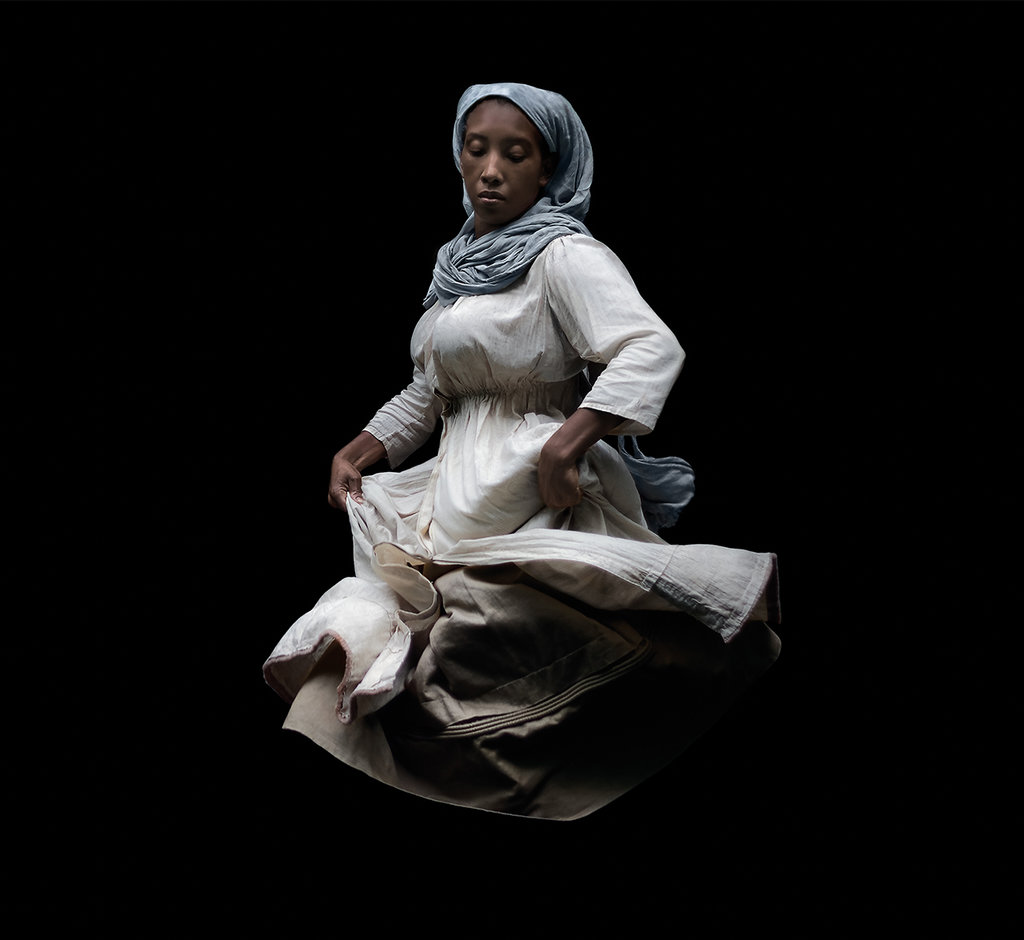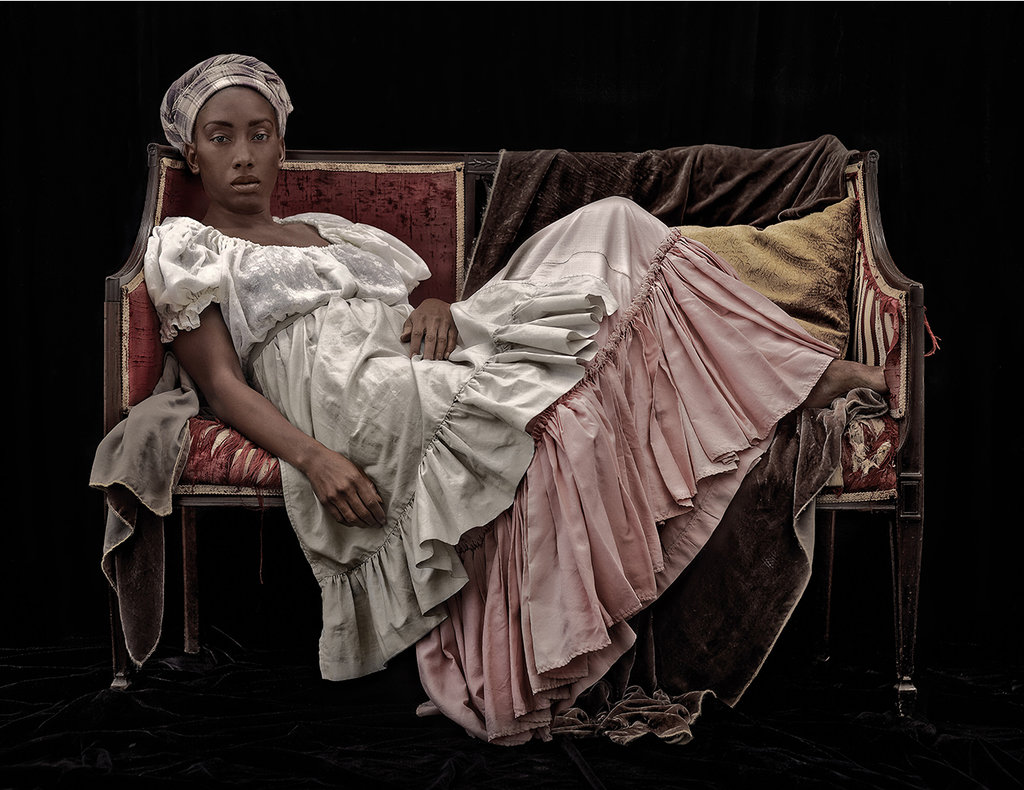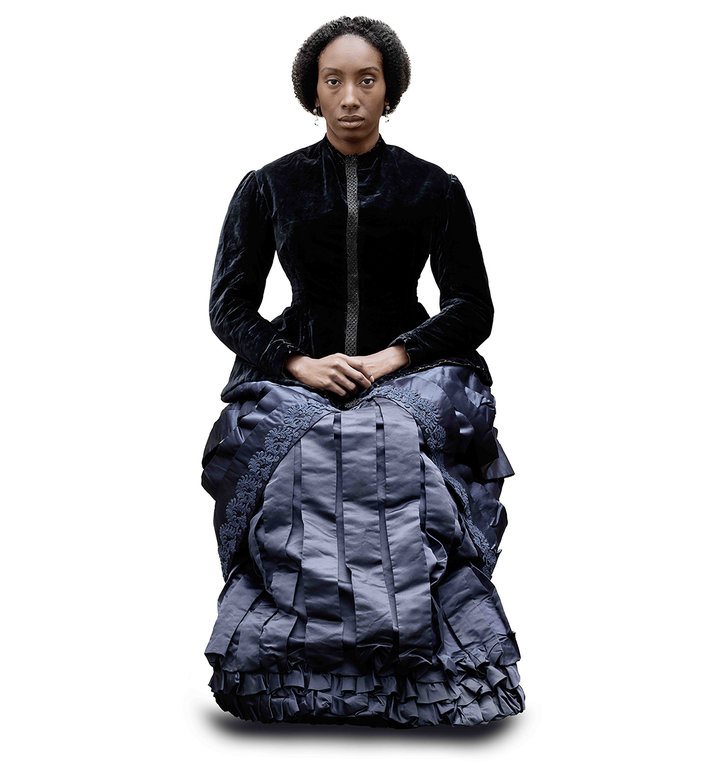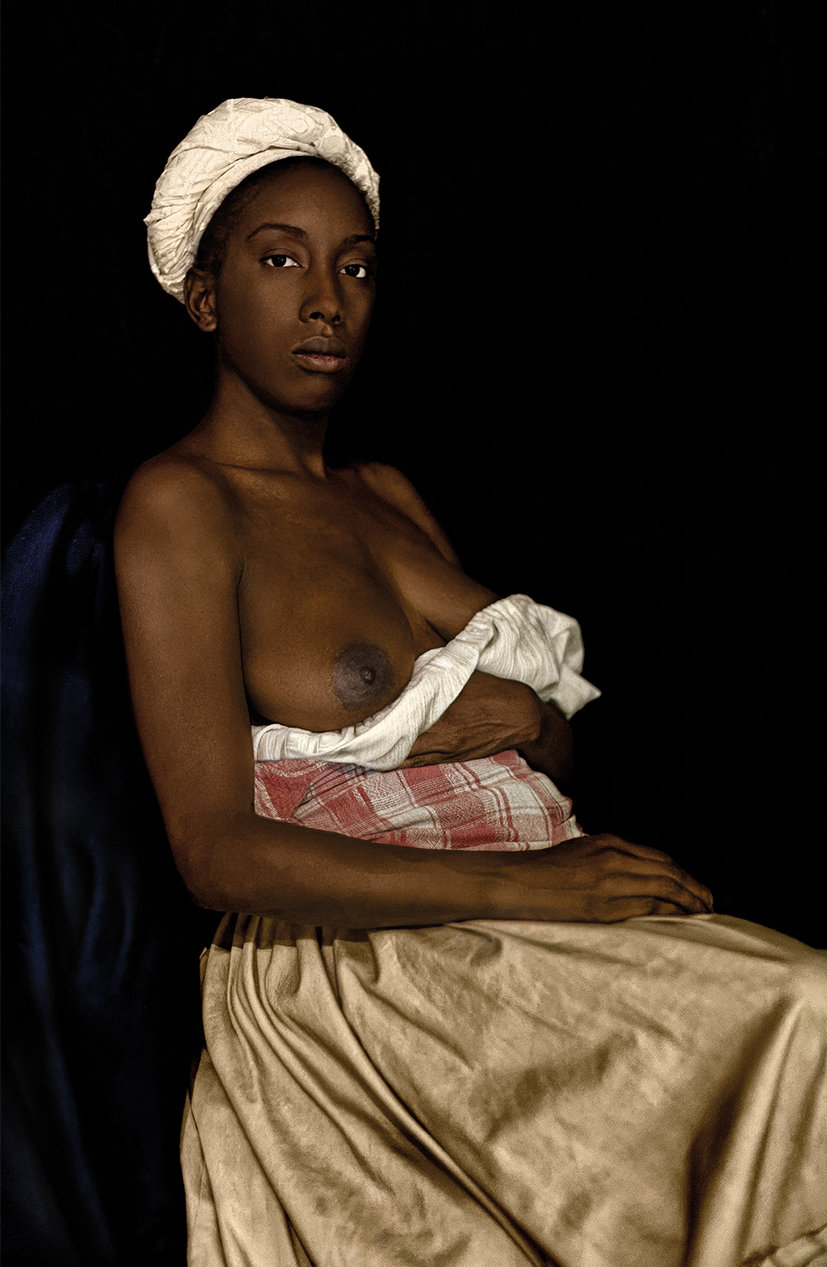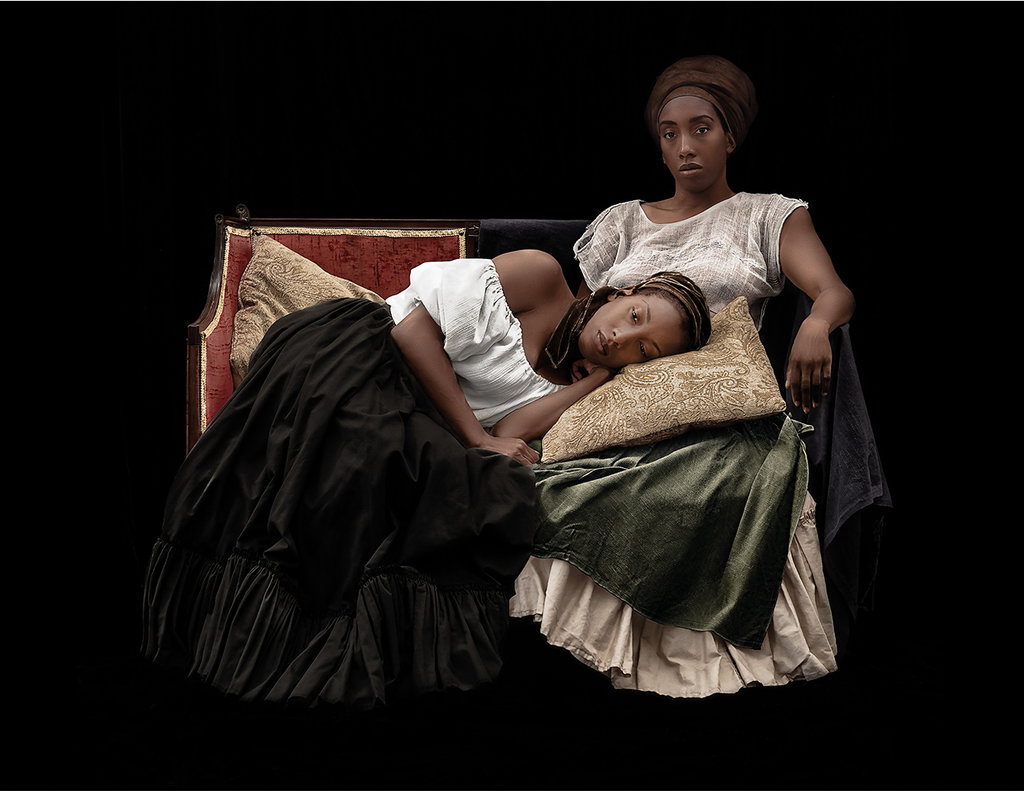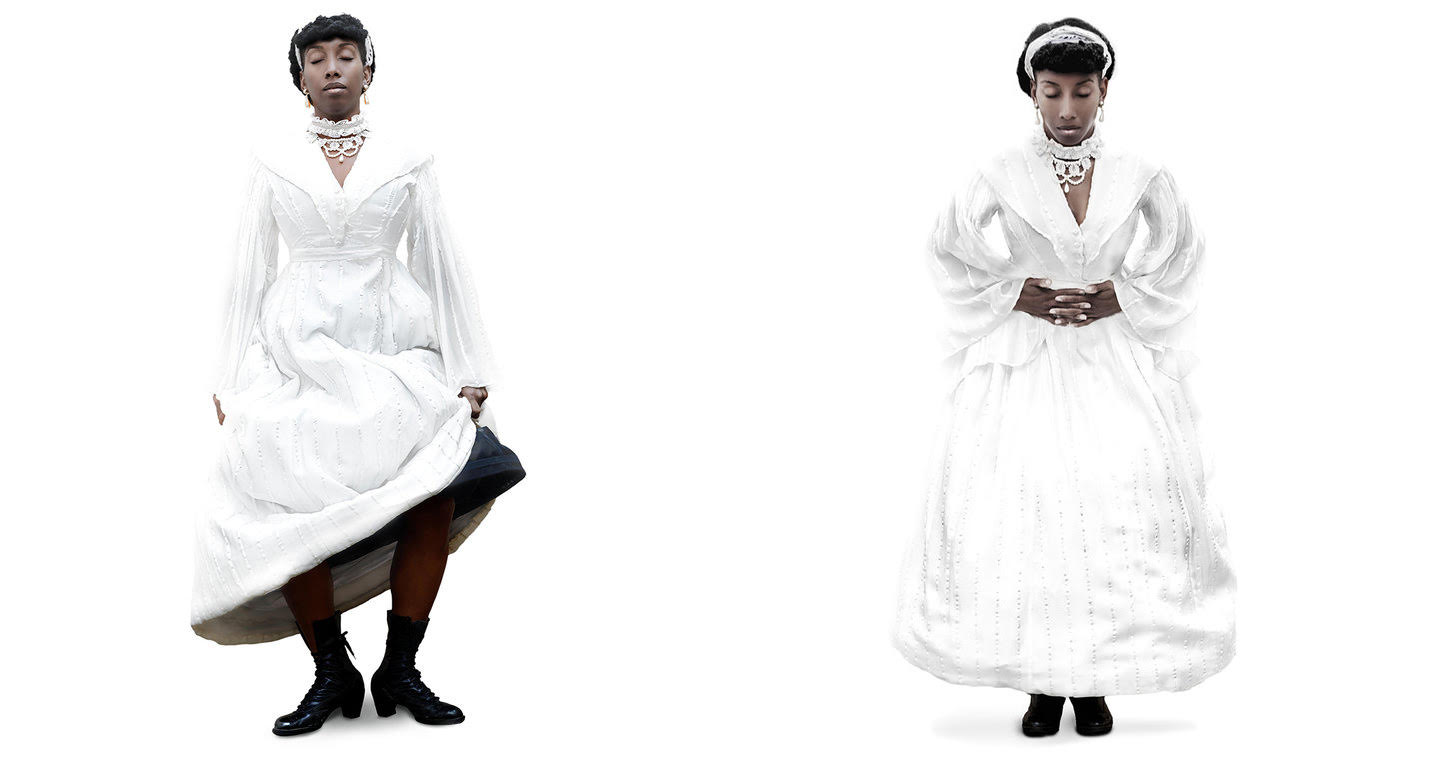Jackson’s Fissure, presented by Scotiabank Contact Photography Festival in partnership with Campbell House Museum, exhibits a selection of photographs from her two earlier series Intimate Justice in the Stolen Moment (2017) and Dear Sarah (2016). Jackson’s art is the materialization of activism against what she describes as the “hyper-sexualisation and objectification” of black bodies, and explores black identity by deconstructing racial and gender stereotypes embedded in her reference material – 19th and 20th century archival photographs.
Jackson’s studio-based portraiture involves using a camera attached to a computer screen in a process that she describes as “performing characters” in a mirror and playfully dancing women.
Ayana V. Jackson, Seeking the Source of Perfection, from the series Intimate Justice in the Stolen Moment, 2017
As Jackson’s first exhibit in Canada, Fissure is loaded with socio-political connotations that challenge the role of colonial racism and transatlantic slavery in the construction of black identity within fine art and photographic portraiture. As an extension of her earlier series Archival Impulse and Poverty Pornography (2013), Intimate Justice in the Stolen Moment represents the black female body not as the enslaved, abused or colonized but as women in ‘stolen moments,’ in respite, far away from captivity. Jackson’s art interrupts the colonial-ethnographic stereotype of black identity by breaking the false narrative paradigm of the angry, unrestrained black woman and replacing it with a calm weightless vulnerability and sensuality for the public’s gaze.
Ayana V. Jackson, Saffronia, from the series Intimate Justice in the Stolen Moment, 2017
The subjects of Jackson’s self-portraits merely seek a moment of solitude, intimacy and fragility which the viewer can relate to. In visiting Campbell House, the reality of colonial racism resonates with the knowledge that the heritage house was built in 1822 before slavery was abolished in Canada in 1834. The importance of Jackson’s self-portraits Saffronia and Sarah Forbes above the mantelpieces alongside the stern portraits of Sir William Campbell and his wife cannot be over-stated as a literal step toward the reconstruction of black identity within the contemporary international art world.
Ayana V. Jackson, Sarah Forbes, from the series Dear Sarah, 2016
In questioning gender and racial stereotypes through self-portraits, Jackson described how she has become “less guarded” to the representations of violence and nudeness. Explaining her process, Jackson stated that “because I’m dealing with images that are politically complex and problematic, I felt that I had to use my body.” Jackson maintains that she is “not giving permission to objectify,” but rather trying to bring attention to the true nature of black women in their elaborate characters and beauty.
Ayana V. Jackson, Lucy, from the series Intimate Justice in the Stolen Moment, 2017
Jackson’s work in the Intimate Justice series also captures those cherished seconds of comfort, joy, sweet tenderness and kindness unrelated to slavery, servitude or hardship. Moments of Sweet Reprieve intimates compassion and calmness, a humanity that Jackson’s work communicates in order to change societal preconceptions of slavery and black identity.
Ayana V. Jackson, Moments of Sweet Reprieve, from the series Intimate Justice in the Stolen Moment, 2017
Samples of Jackson’s Dear Sarah series that appear in Fissure document the life of a young 19th century Yoruba princess named Aina (renamed Sarah Forbes Bonetta) who was liberated from captivity with the help of the British, and later became the goddaughter of Queen Victoria of Great Britain. Jackson recreates archival images of Sarah by imagining and recreating her playfulness and joy in S. Bonetta and her noble ancestry as an African princess (as recognized by Queen Victoria) in Sarah Forbes.
Printed on fabric the Dear Sarah series hang from the ceiling of the Ballroom in Campbell House Museum swaying to the movement of visitors, inviting the viewer to identify with the vulnerability of “being a black woman in white spaces…grappling with blackness.”
Ayana V. Jackson, S. Bonetta, (left) and Etta from the series Dear Sarah, 2016
With a degree in sociology, Jackson utilizes the study of iconography, African and European adornment, portraiture and the transatlantic voyage of slaves to the Americas in order to develop her oeuvre in questioning and challenging the existing theories. Jackson’s work embodies a sensitive, emotional reality of endurance and resilience in the black female body, which she described as “A movement study. Everything that I am doing at the moment is about that. I am looking for motion and weightlessness. I want to shake the load off. My work has always been quite political. It is perhaps aesthetic, but it is ultimately a form of activism. I want to liberate the black body.”
Keren Sedmina
Images are courtesy of Scotiabank Contact Photography Festival, Ayana V. Jackson, and Galerie Baudoin Lebon.
*Exhibition information: Ayana V. Jackson, Fissure, May 1 – June 2, 2019, Campbell House Museum, 160 Queen St. West, Toronto. Gallery hours: Tue – Fri 9:30 am – 4:30 pm, Sat – Sun 12 – 4:30pm.

